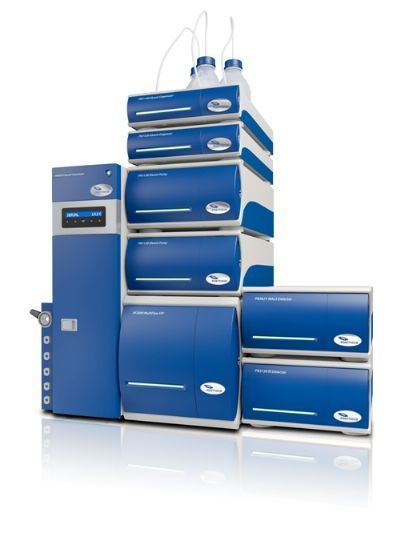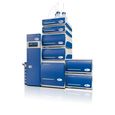方案详情
文
聚血红蛋白,是一种人造血液。目前,其研究方兴未艾。postnova的AF2000AT/MT仪器,可以很好地分离-分析聚血红蛋白,测试其分子量分布、尺寸分布。如果结合激光散射检测器MALS,还可以测试其绝对分子量。由于聚血红蛋白分子量分布可能比较宽、高分子部分的分子量可能非常大,超过了GPC的分离上限,因此,GPC无法完整、全面、真实地测试其分子量分布,那么,AF2000AT/MT就是更好的选择。样品无需过滤,即可直接进样分析。
方案详情

www.postnova.com·info@postnova.com22.10.03-15:2099-06-12-01 NovaSheet Technology: AF4-UV/Vis Application: Poly-Hemoglobin for Blood Substitutes Polymeric Hemoglobin is one of the most interesting compounds inthe area of synthetic blood research. World-wide research for blood substitutes is an ongoing task toovercome the limited resources of natural blood supplied by humans.The demand for blood is expanding more and more as a direct result ofthe growing age of the human populations and the ever increasing levelof medical services supplied to the patients. Most of the complicatedhigh tech surgeries (heart, cancer, etc.) require immense amounts ofblood during the medical treatment. Blood Is Mostly Water For almost a hundredyears saline has beenused to replace lost bloodvolume. But it does nothave the same electrolytecomposition as; humanblood plasma and it is farless effective or safewhen directly comparedto blood plasma. Laterthis was then improved toRinger's lactate, butsaline is still being usedfor volume replacement. At present, the most commonly used product to replace blood loss isthe Ringer lactate solution; this is nothing more than a solution ofelectrolytes and glucose in concentrations similar to those found inplasma. But, it contains no plasma protein and no blood cells, so inmore severe blood loss it is not enough to supply oxygen to the tissue. To increase the oxygen-carrying capacity of the solution, red blood cellsubstitutes have to be added. These products fall into two categories,those solutions derived from hemoglobin, a natural human compoundthat carries oxygen, and the perfluorocarbons, which are syntheticcompounds made from carbon that are able to carry oxygen. Perfluorocarbons The perfluorocarbons under study have the advantage that they can beexcreted through the kidneys and vaporized through the lungs. On thedownside, they alter the way the body fights infections, producing a flu-like syndrome. Perfluoro chemicals are cheap and are completely freeof biological materials so there is no risk of infectious agentscontaminating them. In order to work, they must be combined withother materials that enable them to mix in with the bloodstream. Thesecompanion materials are fatty compounds known as lipids that take theform of an emulsion. They form a suspension of extremely smallparticles in a liquid that can be injected into a patient. The emulsion isrelatively unstable and must be kept frozen until time of use. For the analysis of this group of blood substitutes we recommend ourNovaSheet ,,Characterizationofperfluorocarbon emulsionbbySedimentation FFF (Please inquire at postnova for more information onthis application!). This applications sheet highlights the advancedcharacterization of this complex mixtures by the unique postnovaSedFFF technology. Poly-Hemoglobin The hemoglobin solutions can be derived from outdated human blood,bovine sources, or synthesized by recombinant technology. Thedownside to hemoglobin solutions produced from outdated humanblood is that there is still a potential risk that the material carries adisease. By using recombinant hemoglobin technology the disease riskcan be eliminated. That is one reason most scientists focus on therecombinant hemoglobin. But researchers are also facing another challenge. Every hemoglobinmolecule in the human body is enclosed by a protective membrane orcovering of the red blood cell. Once a hemoglobin molecule is removedfrom that covering, the hemoglobin tends to break apart into particlescalled dimers. These dimer particles are toxic and can cause severedamage to the lungs or kidneys. Thus many groups use glutaraldehydeto bind and polymerize the hemoglobin molecules together, so theydon't break apart in the bloodstream. In order to completely characterize these polymers, Asymmetric FlowFFF is the analytical tool of choice. In the following an example for thecharacterization of poly-hemoglobin using AF4-UV is shown. Fig.1: Characterization of Poly(Hemoglobin) using AF4 coupled with UV. Why use Asymmetric Flow FFF and UV for thecharacterization of poly-hemoglobin? High resolution separation of protein & aggregatesFast, gentle and nearly interaction free separationwithout stationary phase. Fraction collection and easy direct coupling withfurther analytical techniques as MALDI, ELISA, etc. For further information about the characterizationofpoly-hemoglobin by FFF and more literatureplease directly contact us at: info@postnova.com.
确定

还剩1页未读,是否继续阅读?
上海积利科学仪器有限公司为您提供《血液替代品:聚血红蛋白的分子量分布测试》,该方案主要用于全血/血清/血浆中--检测,参考标准--,《血液替代品:聚血红蛋白的分子量分布测试》用到的仪器有非对称流动场场流分离仪
相关方案
更多









